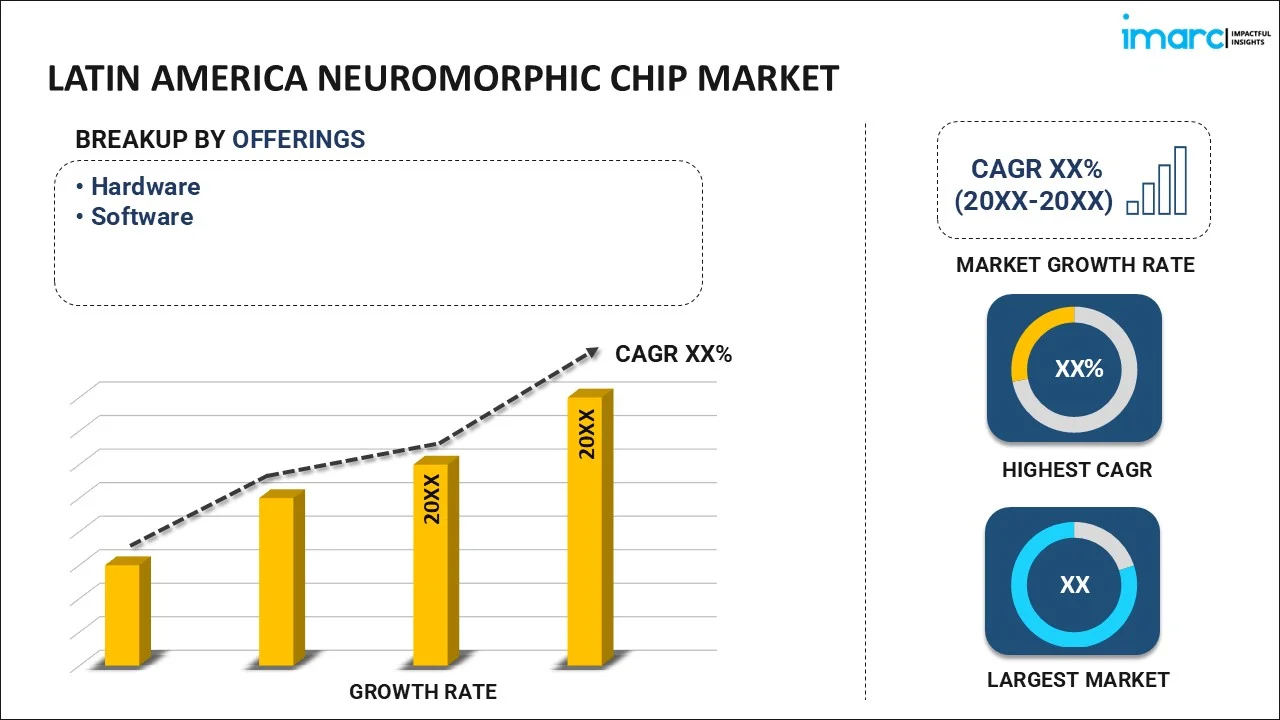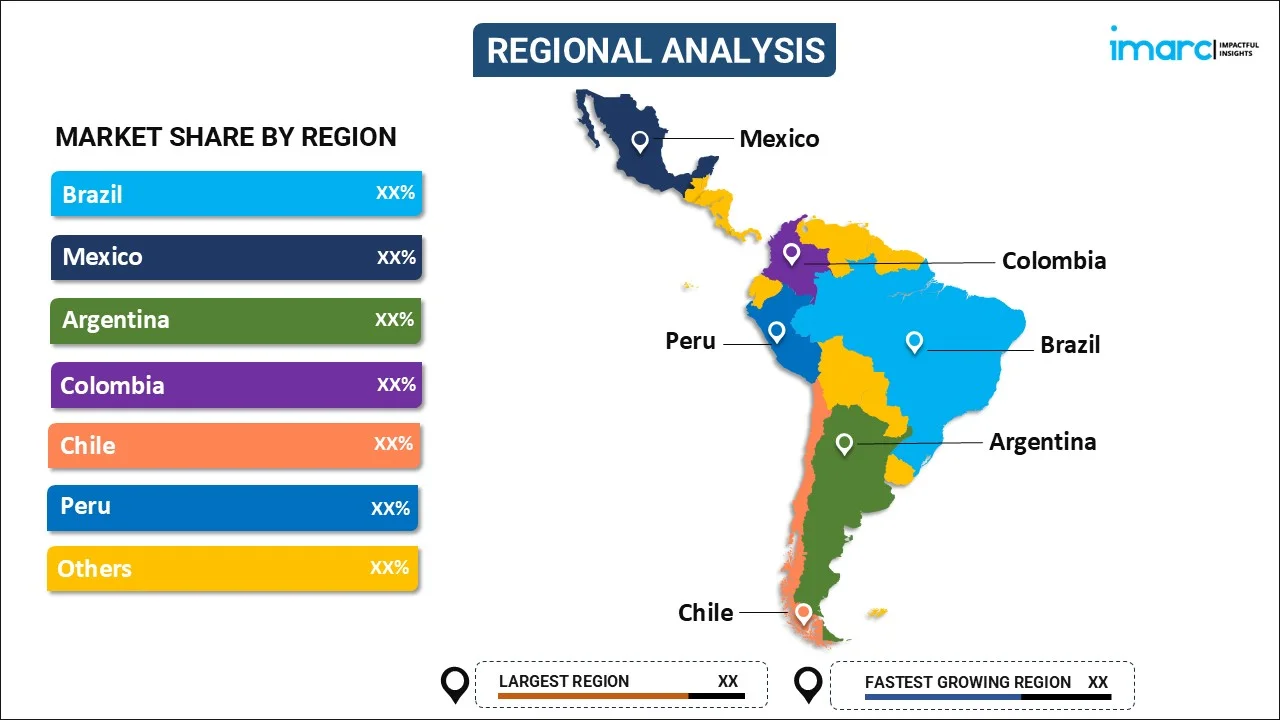
Latin America Neuromorphic Chip Market Size, Share, Trends, and Forecast by Offering, Application, End Use Industry, and Region, 2025-2033
Latin America Neuromorphic Chip Market Overview:
The Latin America neuromorphic chip market size reached USD 255.50 Million in 2024. Looking forward, IMARC Group expects the market to reach USD 1,177.22 Million by 2033, exhibiting a growth rate (CAGR) of 17.70% during 2025-2033. The increasing demand for artificial intelligence (AI) and machine learning (ML) applications, significant advancements in AI research, growing investments in smart technologies, and the rising need for energy-efficient, high-performance computing solutions are some of the major factors propelling the market growth.
|
Report Attribute
|
Key Statistics
|
|---|---|
|
Base Year
|
2024 |
|
Forecast Years
|
2025-2033
|
|
Historical Years
|
2019-2024
|
| Market Size in 2024 | USD 255.50 Million |
| Market Forecast in 2033 | USD 1,177.22 Million |
| Market Growth Rate (2025-2033) | 17.70% |
Latin America Neuromorphic Chip Market Trends:
Growing Demand for AI and Machine Learning
The increasing use of artificial intelligence and machine learning across various sectors, such as robotics, automotive, and healthcare, drives the need for advanced computing solutions like neuromorphic chips that offer high efficiency and real-time data processing. For instance, in 2023, The Santiago Declaration, created in October in Chile at an important AI summit of senior officials from Latin America and the Caribbean, marks a major organizational change in the region. The statement highlights an increasing dedication to not just engage in but also shape the worldwide conversation on AI. More significantly, it underscores a unified initiative by Latin American and Caribbean nations to create governance and regulatory structures suited to the distinct requirements and situations of Latin America. A major result of this summit is the suggestion to create an intergovernmental Council on Artificial Intelligence for Latin America and the Caribbean. This effort, in accordance with UNESCO's Recommendation on AI Ethics, seeks to strengthen Latin America's abilities in AI, creating a setting where ethical factors and human rights are prioritized in AI development and implementation.
Significant Advancements in Technology and Research
Ongoing advancements in AI research and smart technologies, along with rising investments in innovation, support the development and adoption of neuromorphic chips, which provide enhanced performance and energy efficiency for complex computational tasks. For instance, in April 2024, Intel revealed that it has created the largest neuromorphic system in the world. Designated as Hala Point, this extensive neuromorphic system, first launched at Sandia National Laboratories, employs Intel’s Loihi 2 processor, seeks to facilitate research for upcoming brain-inspired artificial intelligence (AI), and addresses issues concerning the efficiency and sustainability of current AI. Hala Point enhances Intel's initial large-scale research system, Pohoiki Springs, featuring architectural upgrades to deliver more than 10 times the neuron capacity and up to 12 times increased performance. Scientists at Sandia National Laboratories intend to utilize Hala Point for cutting-edge brain-scale computing studies. The organization intends to concentrate on addressing scientific computing challenges in device physics, computer architecture, computer science, and informatics.
Latin America Neuromorphic Chip Market Segmentation:
IMARC Group provides an analysis of the key trends in each segment of the market, along with forecasts at the region/country level for 2025-2033. Our report has categorized the market based on offering, application, and end-use industry.
Offering Insights:

- Hardware
- Software
The report has provided a detailed breakup and analysis of the market based on the offering. This includes hardware and software
Application Insights:
- Image Recognition
- Signal Recognition
- Data Mining
A detailed breakup and analysis of the market based on the application have also been provided in the report. This includes image recognition, signa recognition, and data mining.
End Use Industry Insights:
- Aerospace and Defense
- IT and Telecom
- Automotive
- Medical
- Industrial
- Consumer Electronics
- Others
A detailed breakup and analysis of the market based on the end use industry have also been provided in the report. This includes aerospace and defense, IT and telecom, automotive, medical, industrial, consumer electronics, and others.
Regional Insights:

- Brazil
- Mexico
- Argentina
- Colombia
- Chile
- Peru
- Others
The report has also provided a comprehensive analysis of all the major regional markets, which include Brazil, Mexico, Argentina, Colombia, Chile, Peru, and others.
Competitive Landscape:
The market research report has also provided a comprehensive analysis of the competitive landscape. Competitive analysis such as market structure, key player positioning, top winning strategies, competitive dashboard, and company evaluation quadrant has been covered in the report. Also, detailed profiles of all major companies have been provided.
Latin America Neuromorphic Chip Market News:
- In April 2024, Intel's Guadalajara Design Center in Mexico announced its partnership to develop the world's largest neuromorphic computing system, advancing sustainable AI. Intel Costa Rica, contributing 60% of the nation's R&D exports, boosts the country's position in the Global Value Chain, strengthening Latin America's role in the global chip supply chain.
Latin America Neuromorphic Chip Market Report Coverage:
| Report Features | Details |
|---|---|
| Base Year of the Analysis | 2024 |
| Historical Period | 2019-2024 |
| Forecast Period | 2025-2033 |
| Units | Million USD |
| Scope of the Report |
Exploration of Historical Trends and Market Outlook, Industry Catalysts and Challenges, Segment-Wise Historical and Future Market Assessment:
|
| Offerings Covered | Hardware, Software |
| Applications Covered | Image Recognition, Signal Recognition, Data Mining |
| End Use Industries Covered | Aerospace and Defense, IT and Telecom, Automotive, Medical, Industrial, Consumer Electronics, Others |
| Regions Covered | Brazil, Mexico, Argentina, Colombia, Chile, Peru, Others |
| Customization Scope | 10% Free Customization |
| Post-Sale Analyst Support | 10-12 Weeks |
| Delivery Format | PDF and Excel through Email (We can also provide the editable version of the report in PPT/Word format on special request) |
Key Questions Answered in This Report:
- How has the Latin America neuromorphic chip market performed so far and how will it perform in the coming years?
- What is the breakup of the Latin America neuromorphic chip market on the basis of offering?
- What is the breakup of the Latin America neuromorphic chip market on the basis of application?
- What is the breakup of the Latin America neuromorphic chip market on the basis of end-use industry?
- What is the breakup of the Latin America neuromorphic chip market on the basis of region?
- What are the various stages in the value chain of the Latin America neuromorphic chip market?
- What are the key driving factors and challenges in the Latin America neuromorphic chip?
- What is the structure of the Latin America neuromorphic chip market and who are the key players?
- What is the degree of competition in the Latin America neuromorphic chip market?
Key Benefits for Stakeholders:
- IMARC’s industry report offers a comprehensive quantitative analysis of various market segments, historical and current market trends, market forecasts, and dynamics of the Latin America neuromorphic chip market from 2019-2033.
- The research report provides the latest information on the market drivers, challenges, and opportunities in the Latin America neuromorphic chip market.
- Porter's five forces analysis assist stakeholders in assessing the impact of new entrants, competitive rivalry, supplier power, buyer power, and the threat of substitution. It helps stakeholders to analyze the level of competition within the Latin America neuromorphic chip industry and its attractiveness.
- Competitive landscape allows stakeholders to understand their competitive environment and provides an insight into the current positions of key players in the market.
Need more help?
- Speak to our experienced analysts for insights on the current market scenarios.
- Include additional segments and countries to customize the report as per your requirement.
- Gain an unparalleled competitive advantage in your domain by understanding how to utilize the report and positively impacting your operations and revenue.
- For further assistance, please connect with our analysts.
 Request Customization
Request Customization
 Speak to an Analyst
Speak to an Analyst
 Request Brochure
Request Brochure
 Inquire Before Buying
Inquire Before Buying




.webp)




.webp)












